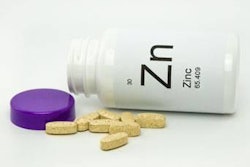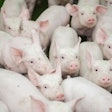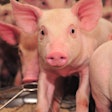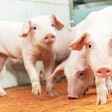
In some parts of the U.S., corn is predicted to go as low as $2.50 per bushel; a vital move for a core ingredient in pig feed. In addition, the record soybean harvest is predicted to drop the price of soybean meal significantly. Although, soybeans have not followed the same pattern as corn — this may be due to global demand.
In the past it took approximately 10 bushels of corn to feed a pig to market weight. That was before dried distillers grains with solubles (DDGS) became a popular ingredient in feed. Now, instead of the feed cost per pig moving $1 for every 10 cent move in corn price, the feed cost moves approximately 70 cents per every 10 cent move in corn. This is the same effect that amino acids have played on soybean meal. In the past, soybean meal dictated a 50 cent change in feed cost per pig with every $10 change per ton of soybeans. Today, a change in $10 per ton of soybeans will only change the price by approximately $35 cents due to the rise in amino acids and DDGS use in pig feed.
When will feed prices be affected by the bumper crop?
Locking in feed prices in the next six to 12 months is still a risk, even with a bumper crop. Factors, such as the oil boom in North Dakota, are causing corn to be stockpiled due to the railways in the states of North Dakota, South Dakota and Minnesota moving oil — not corn. While this is more of a local price drop, a national factor is the ability that grain producers have to store corn in corn bins on their farms so that they can wait for a better price. In 2012 when grain producers were making money, they could afford to build more on-farm storage providing them with leverage during low corn prices like this year. This holding-out strategy gives grain producers more flexibility in the grain price and also makes it more difficult to predict how much of an oversupply of corn the U.S. is dealing with.
Predicting the feed price gets even more tricky for producers because the price of soybean meal is not following the same pattern as corn. Even though the U.S. harvested a record amount of soybeans in fall 2014, the price for soybean meal has not dropped as significantly as the price of corn. This influences how much DDGS and amino acids are formulated into feed, thus impacting how much the overall feed cost will be.
DDGS gains momentum
In fall of 2014, DDGS could be bought from an ethanol plant for $96 per ton. This is half of what DDGS cost in 2013 when it was selling for approximately $216 per ton. DDGS have come a long way from use as a co-product to use as a main ingredient in corn and soybean diets. The price of DDGS will have an effect on how much DDGS is used in feed, but will probably not get to the point where DDGS is not used as a component in feed. The cost of DDGS is approximately 80 percent of the corn price per ton, and 20 percent of the soybean meal price. This means that 100 pounds of DDGS replaces 80 pounds of corn, and 20 pounds of soybean meal.
It is important to know that the recent changes to how corn is processed and oil is extracted is impacting the nutrient profile in DDGS. There is a lot to learn yet on how low-oil DDGS affects growth and carcass quality.
Therefore, feeding recommendations and overall pricing may change more due to the overall effects of feeding DDGS rather than the current corn crop. Six years ago when the price of corn was much higher, producers fed more DDGS to pigs, but that is not the case right now with $3 corn. Because corn is more affordable right now producers can afford to feed more corn and less distillers to finishing pigs, thus decreasing the amount of soft fat that the pig packs on post 200 pounds.
Enzymes threatened by the bumper crop
Right now producers can afford to increase the rate of gain in pigs by feeding more corn and less enzymes. The use of enzymes in pig feed may decrease simply because there hasn’t been any clear-cut data that shows the value of enzymes in nutrient availability. However, this may change with technology rapidly improving our ability to measure the benefits. As a rule of thumb, the more specific the enzyme and its ability to break down fiber — complex carbohydrates — the higher the potential for more enzymes to be used in pig feed.
Amino acids continue to compete with soybean meal
Lysine, methionine and threonine continue to go up in price and will continue as an ingredient in pig feed. Of course the amount that is used in the feed formula will depend on the price of soybean meal and DDGS, as well as the ability for producers to anticipate the price of ingredients in six to 12 months from now. It’s important to note that while corn has dropped from $5 per bushel in 2012 to $3.65 in 2014, soybean meal only dropped from $450 per ton to $435 per ton during this timeframe. While DDGS dropped from approximately $220 per ton in 2012 to $120 per ton in 2014.
Supply and demand concerns
The current feed price predictions may be a perfect case scenario of the old adage buy the rumor, sell the fact — a saying used by investors that means to buy at low prices due to rumors predicting an oversupply, and sell when the actual numbers come out and show that there isn’t an oversupply.
With feed costs averaging $63.88 per pig — down from $87.93 in 2010 — there is still a risk that producers will lock in feed prices down the road that won’t make them money.
Expect changes
An abundance of corn, soybeans and DDGS will affect the pig feed formulations. It is just a matter of when the price of feed will be impacted, and how much. Both corn and DDGS have dropped significantly and are predicted to keep dropping. On the other hand, the record harvest of soybean meal has not made a significant drop on price. With this in mind, amino acids will most likely stay in pig diets. They’ll just be reformulated depending on the market. But only time will tell whether enzymes stay in pig diets or get dropped in 2015.

















